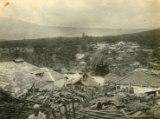Archives
North East An Eye Opener
 Ward’s Lake, one of Shillong’s most sought after tourist destinations was heavily damaged during the earthquake of 1897. These pictures show the devastation on the Lake premises on the fateful day. Ward’s Lake, one of Shillong’s most sought after tourist destinations was heavily damaged during the earthquake of 1897. These pictures show the devastation on the Lake premises on the fateful day. |
 The most shocking and destructive jolt was the Shillong Earthquake, having a magnitude of 8.7, which is believed to be the first earthquake in the country for which instrumental records are available. The fatal day was the 12th of June 1897. After this great earthquake, the first seismological observatory was made in the country by the India Meteorological Department in 1898 at Alipore, Calcutta. During 1898 – 99, two more observatories were set up at Bombay (Colaba) and the other one at Kodaikanal.
The most shocking and destructive jolt was the Shillong Earthquake, having a magnitude of 8.7, which is believed to be the first earthquake in the country for which instrumental records are available. The fatal day was the 12th of June 1897. After this great earthquake, the first seismological observatory was made in the country by the India Meteorological Department in 1898 at Alipore, Calcutta. During 1898 – 99, two more observatories were set up at Bombay (Colaba) and the other one at Kodaikanal.
The great Shillong Earthquake covered 150,000 square miles with its devastating effect, leveling mountain regions, changing the course of rivers, causing fissures on the earth’s surface besides damaging houses and property. Most of the houses of those days were of stone and bricks, many of which came tumbling down especially in Shillong, Sylhet (now in Bangladesh), Guwahati, Goalpara, Dhubri and Tura, killing 1,500 people, of which 600 alone were killed in the Khasi Hills of Meghalaya especially in the Ri War area of the Shella region of the state adjoining Bangladesh.
 Reverend Robert Evans of Bangor who was a missionary to the Welsh Calvinistic Methodist Presbyterian Mission Field in the Khasi – Jaintia Hills between 1878 to 1901 had given an eye – witness account of the tragedy. “When everything was going along in the usual, peaceful way, with no one thinking about anything out of the ordinary, on the 12th of June 1897, between four and five in the afternoon, the inhabitants of Khasia experienced one of the greatest earth tremors known in any country.”
Reverend Robert Evans of Bangor who was a missionary to the Welsh Calvinistic Methodist Presbyterian Mission Field in the Khasi – Jaintia Hills between 1878 to 1901 had given an eye – witness account of the tragedy. “When everything was going along in the usual, peaceful way, with no one thinking about anything out of the ordinary, on the 12th of June 1897, between four and five in the afternoon, the inhabitants of Khasia experienced one of the greatest earth tremors known in any country.”
“The very face of the land underwent huge changes. At the end of the short spell, every stone house had become a pile of rubble while every wooden house was bent and twisted, taking on almost every shape imaginable until they were totally unsuitable for habitation. Massive landslips took place in every direction. In some places, hundreds of thousands of tons of earth from the hill slopes were carried down many hundreds of feet with a deafening sound. Within a few seconds, lofty hillsides; previously made beautiful by grass and trees were visibly denuded in every part. Great forests were hurled to the valley floors and so were the earth and rocks under them until the land was made to appear raw red and scarred even as they earlier looked smooth and verdant.
 The cause came like a thunder bolt, creating dread and unforeseen destruction. People had no warning, only in the sense that the earthquake, which was unusually feeble from the start, did not gain full force for six or seven seconds. This was how long they had to flee from their homes.
The cause came like a thunder bolt, creating dread and unforeseen destruction. People had no warning, only in the sense that the earthquake, which was unusually feeble from the start, did not gain full force for six or seven seconds. This was how long they had to flee from their homes.
According to official records, the first railway line in the Khasi Hills was totally destroyed during the Shillong Earthquake. In many places, the railway lines were completely twisted and the railway station building was damaged. The road from Shillong to Guwahati was badly damaged for about half of its length between Shillong and Nongpoh by landslips and fissures on the 63 mile long road. All bridges collapsed except for the ones at Barapani and Burnihat. Great chasms of 30 feet depth had opened up between the 24th and 29th miles.
However, surprisingly, most of the giant monoliths spread out in the landscape of the Khasi – Jaintia Hills including those at Nartiang withstood the great Shillong Earthquake which speaks of the Khasi genius in the erection of these monoliths which are connected mostly with religious ceremonies and sanction of the traditional religious practices.
 Thomas Oldham Esq. LLD, FRS, Superintendent of the Geological Survey of India made a list of all the earthquakes in India. The first one mentioned for its influence in Assam is the earthquake of 6th July 1505. Historical records indicate that several large intensity earthquakes occurred in the North East in 1663, 1845, 1852 and 1875. The earthquake of August 15th on Independence Day, 1950 caused heavy damage over the entire region and claimed 1,500 lives.
Thomas Oldham Esq. LLD, FRS, Superintendent of the Geological Survey of India made a list of all the earthquakes in India. The first one mentioned for its influence in Assam is the earthquake of 6th July 1505. Historical records indicate that several large intensity earthquakes occurred in the North East in 1663, 1845, 1852 and 1875. The earthquake of August 15th on Independence Day, 1950 caused heavy damage over the entire region and claimed 1,500 lives.
The North East region falls within the high risk zone V, in which the Shillong region also falls. The September 18th quake in Sikkim falls within zone IV and was caused because of a collision between the Eurasian plate and the Indian plate. According to the Shillong based Central Seismological Observatory, Sikkim’s Sunday earthquake was at latitude 27.7 degrees north and 88.2 degrees east on the Sikkim – Nepal border. The depth of the tremor was shallow at 10 kilometres below the earth’s surface. Most of the quakes occurring in the region are related to subduction of the India – Burma tectonic plate under Java – Sumatra tectonic plate.
| All Saints’ Church, the oldest church of Shillong was one of the buildings which was completely levelled by the earthquake. These pictures show the extent of the devastation. |
In such a situation, dams constructed in the region for the generation of hydro electric power especially big and mega dams pose high risks, especially those located near seismic sources. The performance analysis of these structures including dwellings and bridges is therefore essential to reduce seismic hazards.
All Photos by - Roger Bilham 2007

